When carrying out construction work, much attention is paid to finishing the facades of buildings with special coatings that provide them with an attractive appearance and protect them from bad weather. The emergence of materials, unique in their characteristics, made it possible to introduce the latest finishing technologies into construction. One of these innovations is the ventilated façade, which can be installed from the basement to the very roof.
Defining a ventilated facade

Installation of suspended or ventilated facade systems is one of the methods of exterior cladding of buildings using a special frame. A feature of this technology is the order of arrangement of the structure, when a small gap is left between the walls and finishing elements. Due to this, air flows enter the formed space and ventilate the entire hinged structure. Such arrangement of the facing layer reliably protects the facade from waterlogging and reduces heat loss through this part of the building.
Modern hinged facade systems are widely used in the decoration of public buildings, as well as in private construction. Ventilated porcelain stoneware facades, for example, are at the same time part of the decoration of a house. Several types of such structures are known, differing in the composition of their constituent elements and performing a specific function.
Design features
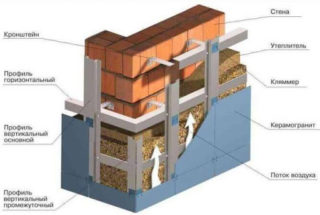
The ventilated system includes:
- a layer of protective and decorative material;
- frame with fasteners;
- insulating layer;
- ventilation gap.
The supporting frame as a separate subsystem consists of aluminum struts, brackets, special crossbars and anchor bolts with rivets. In addition to its unifying function, it transfers the load from the cladding slabs to the walls of the building and protects them from strong vibrations.
An insulating layer is a combination of heat-shielding materials that are impervious to steam and moisture, which are fixed directly to the walls by means of mechanical bolts. The use of a special construction adhesive does not guarantee high-quality adhesion to uneven surfaces. The insulating coating includes a layer of insulation made of mineral wool, foam or classic polyurethane foam.
The choice of a specific type of this material is determined by the following factors:
- the required level of thermal protection;
- water tightness specified in the project;
- safety (fire protection).
- permissible noise level.
The air gap between the outer cladding and the insulating layer is made so that air can circulate freely in the working cavities (about 40-100 mm). To increase the efficiency of its exchange, ventilation holes are made from below and from above, equipped with grilles, which exclude the ingress of foreign objects into the structure.
Varieties of ventilated facades
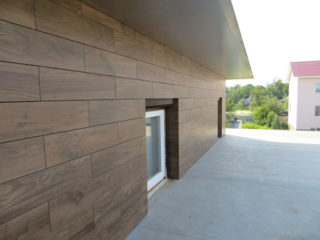
According to the type of facing material, curtain wall systems are divided into the following categories:
- composite;
- fiber cement;
- based on porcelain stoneware;
- terracotta ceramics and others.
Composite panels
Composite or aluminum panels are the most common type of ventilated facades, characterized by long service life (up to 50 years). They are characterized by increased resistance to climatic factors and corrosion. The features of the device of composite structures and their low weight allow to reduce the working load on the walls of the building.
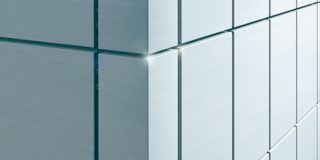
A typical panel is made in the form of two aluminum sheets, between which a layer of polyethylene is placed. On the inside, such a plate is treated with an anti-corrosion compound, and on the outside, a protective layer of polyester is applied to it.
The use of composites provides the following benefits:
- good sound insulation and improved anti-vibration characteristics;
- high strength and flexibility of panels;
- UV resistance and a variety of colors.
The facade decorated with composite sheets well emphasizes the individual style of the building. The disadvantages include low maintainability of the structure and its high cost.
Fiber cement boards
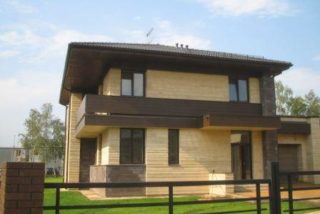
Facade decoration in the form of fiber cement slabs is very popular among builders, due to its low price and versatility. They are based on cement with hydraulic additives made from reinforcing fibers, which improve the moisture resistance of the board and increase its strength.
Pressed sheets with the specified additives are first hardened and then placed in autoclaves. There, under the influence of high temperature and pressure as a result of polymerization, they acquire their final appearance.
Material pluses:
- light weight;
- corrosion resistance;
- Fire safety;
- quick installation;
- resistance to temperature extremes;
- environmental Safety;
- affordable cost.
The disadvantages of these products are high sensitivity to mechanical stress and deformation. Despite this, fiber cement boards are a profitable solution for the design of facades of residential buildings and industrial buildings. They imitate well such popular materials as stone or brick, which significantly expands their scope.
Porcelain stoneware
Ventilated porcelain stoneware facades are a very common way of decorating buildings. Such panels have a number of advantages:
- aesthetics, providing the facade with an attractive appearance;
- a wide range of structural elements and colors that allow you to decorate the front of the building in the desired architectural style;
- high speed of panel mounting and low consumption of fastening material;
- resistance to aggressive environments;
Porcelain stoneware ventilation facades are resistant to sudden changes in temperature and humidity, as well as to ultraviolet radiation. In addition, they are distinguished by good sound insulation, which is especially important for objects located on busy highways.
Bulk terracotta ceramics
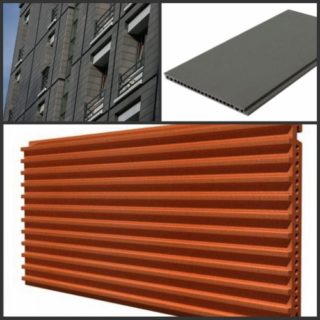
Terracotta panels are made on the basis of specially processed clay. This original and high-quality material allows you to implement the most daring design decisions. They are produced in 2 versions: with a natural matte shade or with a textured surface. Of the advantages of such panels, the following are especially noted:
- good sound insulation;
- Fire safety;
- increased strength;
- resistance to low temperatures;
- attractive design.
Since the weight of clay products is quite large, the load on the facade surface is calculated before installation. Terracotta panels are widely used in the decoration of residential buildings, business centers, as well as the outer walls of shopping and entertainment complexes.
When installing them, special mounting subsystems are used. Since cover plates differ in shape, thickness and weight, they must be selected individually during installation.
Clinker tiles allow you to simulate brick finishes while being superior in efficiency. Clinker products are distinguished by long service life and increased strength (resistance to deformation). HPL laminate panels are as strong and dense as terracotta, but come in a wide variety of colors.
Installation rules
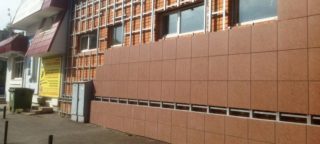
General order of installation of ventilated facade elements:
- Scaffolding is installed along the facade, covered with plastic film from the outside.
- The working area is marked out according to the project.
- Mounting elements (subsystem brackets) are installed.
- In the intervals between them, sheets of thermal insulation and wind protection are attached.
- Horizontal guides are mounted to fix the facing blanks, as well as elements of slopes and ebbs.
- Outside corner holders are installed.
At the final stage of work, the panels themselves are attached to the equipped frame.
Ventilated facade waterproofing
One of the components of a ventilated facade is a waterproofing layer applied over the insulation boards. This element is not considered required and is mounted at the discretion of the contractor.
The density of the insulation material used must be taken into account. If it does not exceed 80 kg per cubic meter, waterproofing is not necessary. Otherwise, you will have to worry about protecting the insulating layer from moisture.








